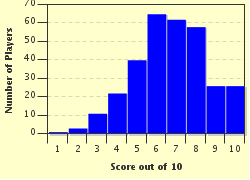Quiz Answer Key and Fun Facts
1. A peanut can have a nice crunchy consistency and the typical meaty taste of most nuts, and it even has "nut" as a part of its name--but it is not a nut. What is a peanut ... really?
2. Particularly in the U.S.A., one brightly colored insect is commonly known as the lady bug. It is not really a bug, though. What species is it?
3. In the U.S.A., people often enjoy a tasty treat called shortbread that is made of sugar, butter and flour, which is most commonly baked without leavening. It is not, however, a bread. What is it?
4. Have you ever bumped your elbow and exclaimed, "Ooooo, I hit my funny bone?" The human skeleton has no "funny bone" within its configuration, so what is this area we call the "funny bone"?
5. The lightweight, pale colored straw hat that is often called a Panama hat is indeed a hat, but its origin is not Panama. Where were these popular head coverings originally made?
6. This novelty item was very popular in the 1950s and 1960s. It was amazing at best and entertaining at the very least. The Mexican jumping bean could be quite mesmerizing. Though commonly called "bean", it is not a bean. What is it?
7. A tasty entrée that can include a plethora of meats and vegetables is often prepared on a griddle and more than likely "made to order" by the customer selecting the ingredients to be grilled. What is this cuisine, commonly known by a country that does NOT accurately reflect its origin, and a preparation process that, too, is not entirely correct?
8. The artichoke is a plant native to the Mediterranean area. It is a member of the thistle family whose flowers and stems are considered flavorful when eaten. Another similarly named item is the Jerusalem artichoke. What part of it do people (usually) eat?
9. During the early part of the 21st century, pop culture once again embraced an appreciation for the elegant and entertaining aspects of ballroom dancing. One such lovely and well-liked dance is the foxtrot. How did it get its name?
10. Worldwide we may not see a lettuce shark every day, but it is a very interesting animal. It is NOT, however, a shark. What is a lettuce shark?
Source: Author
cowboybluedog
This quiz was reviewed by FunTrivia editor
Pagiedamon before going online.
Any errors found in FunTrivia content are routinely corrected through our feedback system.

